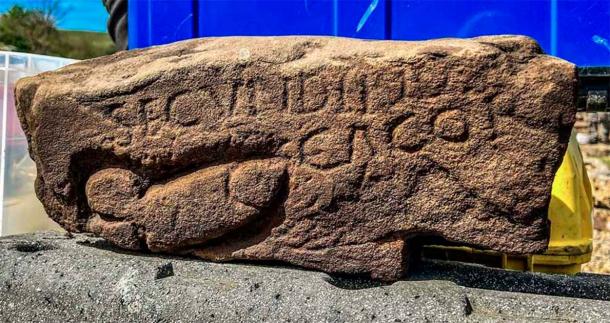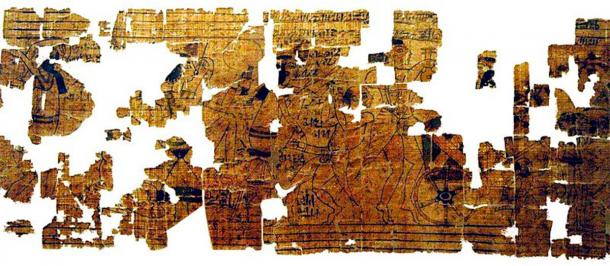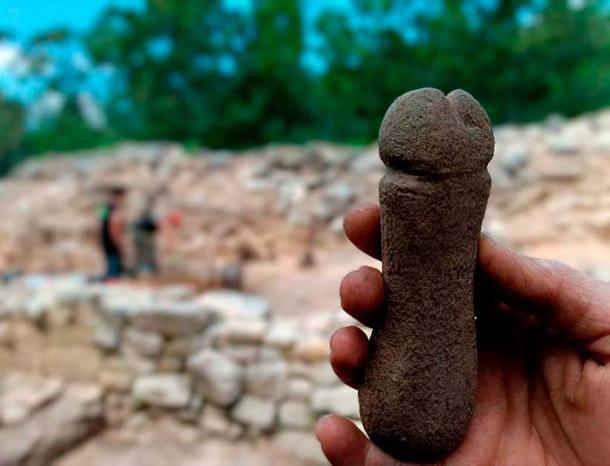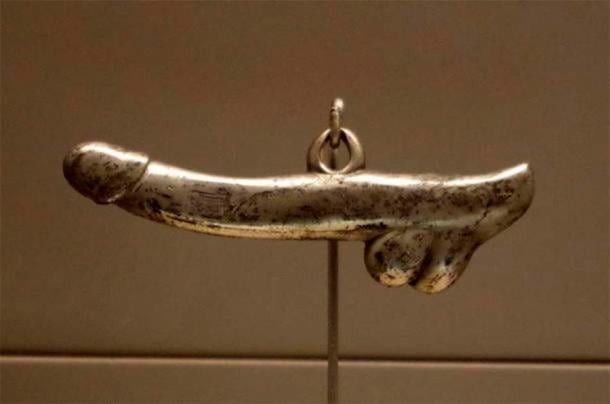8 Famous Phalluses from History and What They Represent
1.Hohle Fels Phallus – An Old German Penis
We start our list with one of the earliest representations of male sexuality ever discovered. The Hohle Fels phallus is a 28-centimeter (11-in) penis-shaped object believed to be around 28,000 years old. It was found buried in Germany’s famous Hohle Fels Cave near Ulm.
What it was used for is a matter of some debate. It was intricately carved from a mammoth tusk and much workmanship appears to have gone into it. Some historians have suggested it served as a fertility symbol, used in ancient fertility rituals. This is, of course, the obvious answer. Every time an ancient phallus is found historians point to fertility rituals.

Hohler Fels Phallus, aged about 27-30000 years. Discovered in 2004 in cave “Hohler Fels” in the Ach Valley near Schelklingen, Germany. (Hannes Wiedmann, CC BY-SA 4.0 )
Other researchers believe it had more practical uses. The Hohle Fels phallus may have actually been an early kind of multi-tool. Besides its use as a fertility symbol, the fact it’s ‘life-sized’ (if you were born particularly lucky) has led experts to believe this particular phallus was used as a sex aid. Making it one of the oldest ever discovered sex toys .
Yet that’s not all. The Hohle Fels phallus may have had a third, even more, practical use – knapping flints. This is a process of snapping and shaping flint so that it can be made into tools. The Hohle Fels phallus shows the typical scars of being used for this.
2.Shiva Lingam – Lord Shiva’s Energy
The Shiva Lingam is deeply connected to Hindu mythology and is an iconic depiction of Lord Shiva, one of the main deities of the Hindu religion. It’s a phallic-shaped stone/ pillar that symbolizes his divine creative energy and the cosmic male principle, Shiva.

Shiva lingam. ( saiko3p / AdobeStock)
Lingam translates as “mark” or “sign,” and it represents the power of creation. Lingams usually consist of an elongated oval shape with a rounded top, forming a phallus. Alongside representing creation, the lingam also marks the union of the masculine and feminine energies, encompassing both creation and destruction.
Shiva Lingams can usually be found in temples that are dedicated to Lord Shiva . The Lingam is worshiped as a formless manifestation of Lord Shiva and as a potent symbol of fertility, regeneration, and spiritual awakening. As such it is bathed with water, milk, and other sacred substances as a mark of reverence.
Shiva Lingams are beautifully carved and every part of their form holds meaning. They embody the concept of the eternal cycle of life, death, and rebirth. Its smooth, rounded form represents purity and wholeness, while its upward-pointing nature signifies the upward journey of consciousness toward enlightenment.
3.Of all Phalluses: The Cerne Abbas Giant – Very Well Endowed
In the case of the Cerne Abbas Giant size clearly did matter. Carved into a hillside in Dorset, England the Cerne Abbas Giant is believed to be thousands of years old. This geoglyph depicts a male figure wielding a club while sporting a particularly prominent phallus. Said phallus is an impressive 30 meters (98 ft) long.
The origins and purpose of the Cerne Abbas Giant remain a subject of speculation. Some theories suggest that it represents a fertility symbol, or a depiction of a pagan deity associated with virility and procreation. Others propose it could have served as a territorial marker or held ritual significance for ancient communities.

Aerial shot of the Cerne Abbas Giant. (Dorset Council / CC BY-NC-SA 2.0 )
Over the years this giant phallus has become an iconic symbol associated with the site and it has become regarded as a symbol of male potency and sexual power. Due to its chalky nature, the phallus has to be frequently maintained and “re-chalked” to preserve its distinctiveness.
The Cerne Abbas Giant and his impressive phallus are a major tourist attraction and people from all over the world visit to admire this geoglyph. It has become a popular landmark and continues to spark fascination and debate regarding its origins, purpose, and significance in ancient times.
4.The Vindolanda Phallus – Britain’s Oldest Sex Toy
The Vindolanda Phallus , a 2000-year-old Roman relic, was found in 1992 near the ancient Roman fort of Vindolanda, located along Hadrian’s Wall. Originally, it was listed as a darning object, a pestle, or a good-luck charm used to “ward off evil.” Which isn’t terribly exciting. However, when researchers took a second look at it, another use came to mind.
A 3D scan showed that both ends of this 13cm (6.3 in) phallus-shaped object have been worn smooth with “use”. This led researchers to conclude it had either been used for one of the above, or more excitingly, as a sex aid.
While they’re not sure, the fact the Vindolanda phallus is “life-sized”, wooden, and worn smooth has led researchers to conclude it was most likely used as a sex tool of some sort. This would make it a rather exciting discovery. We know from Roman artwork that the Romans and Greeks made use of dildos, but few archaeological examples have been found.

The Vindolanda Phallus discovered near Hadrian’s Wall, was it a Roman dildo or torture device? ( Antiquity/NewCastle University )
It’s believed to be the “first known example of a non-miniaturized disembodied phallus made of wood in the Roman world.” This isn’t to say the Vindolanda Phallus was necessarily used to give someone a good time, however. The Romans weren’t above using dildos as torture devices, used to assert their dominance over prisoners and reinforce power disparities. The fact that the Vindolanda Phallus was found at a fort could point to this more disturbing use case.
5.Roman Penis Graffiti- All Over the Place
Following on from that, perhaps the soldiers stationed at Vindolanda Fort were just a little immature. It’s doubtful there’s a single classroom or men’s bathroom on the planet that doesn’t have a penis etched somewhere in it. The Romans were no different.

This phallus has insulting Roman graffiti above it that was meant for another Roman soldier. The insult reads: “You shi**r!” ( Vindolanda Charitable Trust )
A large, engraved penis drawing was found at Vindolanda Fort with the insult “You shi***r” carved above it. Juvenile? Yes. Funny? A little bit.
What does this phallic symbol mean? Simply put, just like certain young men today, the Romans found it funny to carve enlarged phalluses into walls. The archaeologists at Vindolanda Fort weren’t even particularly surprised to find it. So far, they’ve found 13 such carvings along Hadrian’s Wall.
And it’s not just Hadrian’s Wall. Lots of ancient Roman sites have penises scrawled all over them. Perhaps most famously the wonderfully preserved towns of Pompeii and Herculaneum feature some hilariously bawdy graffiti. For those interested in Roman history, looking at penis graffiti is just an occupational hazard at this point.
6.Turin Erotic Papyrus – An Early Sex Manual
Not all ancient phallic drawings are the work of bored young men with overactive imaginations though. Some phallic drawings were designed to be educational, as in the case of the Turin Erotic Papyrus .
This is an ancient Egyptian document believed to date back to the Ramesside period of Egypt, around the 13th century BC. The papyrus contains a collection of explicit illustrations depicting various sexual acts, including depictions of phalluses, making it a fascinating glimpse into the sexual practices and attitudes of the time.

The Turin Erotic Papyrus, famous due to its erotic content. An ancient Egyptian papyrus scroll-painting dating back to about 1150 BC, it was discovered at Deir el-Medina in the 19th century and was found to include various erotic vignettes which show sex positions ( Public Domain )
The phallic drawings found in the Turin Erotic Papyrus serve as a testament to the ancient Egyptians’ openness and acceptance of sexuality. These drawings display an understanding and celebration of sexual pleasure and desire within the context of their culture. The phallus, as a symbol of male sexual power and fertility, was a prominent element in these illustrations.
While we can’t be sure, it seems likely that the papyrus was created to serve as a form of sex manual or guide, providing instructions or inspiration for sexual rituals and acts. It offers valuable insights into ancient Egyptian beliefs and practices surrounding sexuality, emphasizing its importance in the context of fertility, pleasure, and divine power.
7.Torre de Meira Medieval Stone Penis – A Violent Purpose!
We tend to think of Medieval Europe as being fairly prudish and repressed, but a stone relic found just outside of Torre de Meira in Spain is anything but. The stone penis, roughly six inches in length, has been dated back to 15th century Spain and is believed to have been used during Spain’s Irmandiño War, two peasant uprisings against the Kingdom of Galicia’s noble rulers.

Archaeologists uncovered a medieval stone phallus they believe may have been used to sharpen weapons. ( Árbore Arqueoloxía S.Coop.Galega )
The stone penis was found at the ruins of Torre de Meira, a medieval tower that fell during the peasant revolts. So, what did the tower’s occupants need a stone penis for?
The answer is much weirder than one might have guessed. Historians believe the stone penis was used as a sharpening stone for swords. This was deduced by observing the distinct pattern of wear on one side of the phallic stone ’s surface. But why the phallic shape?
Historians aren’t sure why the soldiers chose to use a whetstone carved into a phallic shape. But there are two options. It might be that the shape was associated with good luck, power, or virility, which is what historians tend to associate phallic symbols with.
However, a more interesting idea is that the phallic symbol was used as an insult or an act of disrespect. The Irmandiño War was a particularly heated, class-based affair with little love loss on either side. It could be that the sword sharpener was mocking his enemy by sharpening his sword on a phallic symbol.
8.Ancient Egyptian Amulets of the God Min- Phallic Fertility Fashion
Not all phallic symbols and artifacts are large, however. Throughout history, it was common for people to wear amulets and other jewelry in the shape of a phallus. A classic example is the Ancient Egyptian amulets depicting the god Min, which held a significant place in the religious and cultural practices of ancient Egypt.
Min was usually portrayed as a fertility deity and was associated with procreation, sexual potency, and agricultural abundance. The amulets representing Min typically depict him with an erect phallus, emphasizing his role as a symbol of virility and procreative power.
These amulets were believed to possess protective qualities and were worn by individuals seeking fertility, protection during childbirth, and overall well-being. The image of Min’s erect phallus on these amulets was thought to ward off evil forces, ensure successful reproduction, and promote the growth and abundance of crops.
But these amulets aren’t unique to Egyptian culture. Other ancient civilizations like the Greeks and Romans also made use of phallic jewelry that served a similar purpose. There was a lot of excitement when in 2020 a silver ‘ Roman Penis Pendant ” dating back to between 43 and 410 AD was found in England and declared a national treasure.

The penis pendants, were worn by children to ward off illness. (David Perez / CC BY 4.0 )
While it might seem strange today many cultures made use of phallic jewelry as both good luck charms and as a way to fend off evil spirits. Houses have been found in Pompeii with large penis drawings etched above their doorways for just this purpose.
Conclusion
There are many more examples than these of ancient phalluses. Humans have been obsessed with genitalia since our earliest days and museums and dig sites across the globe are full of phallic symbols and artifacts.
While it’s funny to think about today, these symbols often held important meanings to their respective civilizations. People put a lot of trust into these phalluses to help them conceive, grant them healthy harvests, and even protect them from evil.
The human form was something beautiful and divine, not something to be shied away from or be ashamed of. These relics serve as an important reminder that in many ways our ancient ancestors were in some ways (but not all) more open-minded and less prudish than we are today. Or in the case of Roman graffiti, a reminder that some comedy is timeless.
Related Post
A shocking documentary proves that mermaids do exist
SHOCKING Revelation: Thuya, Mother of Queen Tiye, Was the Grandmother of Akhenaten and Tutankhamun—What Ancient Egyptian Secrets Did She Leave Behind?
Breaking News: Astonishing Discoveries at Karahan Tepe Confirm an Extraterrestrial Civilization is Hiding on Earth, and NO ONE Knows!
Breaking News: Researchers FINALLY Discover U.S. Navy Flight 19 After 75 Years Lost in the Bermuda Triangle!
NASA’s Secret Investigation: Uncovering the Astonishing Mystery of the UFO Crash on the Mountain!
Explosive UFO Docs LEAKED: Startling Proof That Aliens Ruled Ancient Egypt!